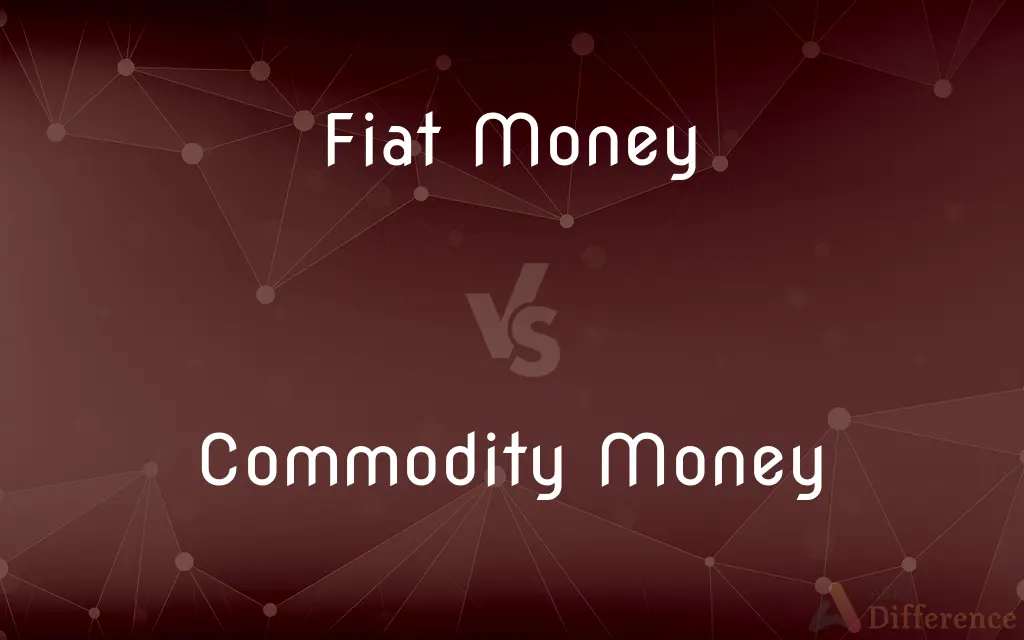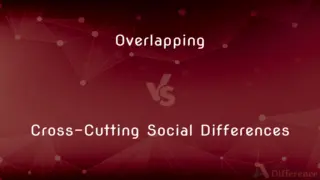Fiat Money vs. Commodity Money — What's the Difference?
Edited by Tayyaba Rehman — By Fiza Rafique — Published on December 9, 2023
Fiat Money is currency without intrinsic value, backed by government decree, whereas Commodity Money derives value from the material it's made of.

Difference Between Fiat Money and Commodity Money
Table of Contents
ADVERTISEMENT
Key Differences
Fiat Money, by definition, refers to currencies that lack intrinsic value. They are not based on a physical commodity but rather derive their value from the trust and confidence of those who use it. Central banks issue Fiat Money, and its value is not determined by any tangible asset but rather by government decree. While it lacks intrinsic value, Fiat Money has become the standard in many economies because of its stability and the backing of governments and their regulatory bodies.
On the contrary, Commodity Money is currency that derives its value directly from the material from which it is made. Historically, many societies used commodities like gold, silver, or even cattle as forms of money. The value of Commodity Money comes from the commodity itself. For instance, a gold coin's value is based on its actual gold content. Because of this inherent value, many argue that Commodity Money is less susceptible to inflation than Fiat Money.
In terms of acceptance, Fiat Money's value is accepted because a government maintains it, making it a legal tender for all debts and credits. This acceptance is a construct of faith and trust in the governing body. Commodity Money, however, is accepted not just because of faith or decree but because of the inherent value of the material it represents. A gold bar, for instance, will have value based on its weight and purity, irrespective of any government's say.
Another difference between Fiat Money and Commodity Money lies in their susceptibility to external factors. Fiat Money can be affected by government policies, inflation rates, and economic conditions. Its value might decrease if a government prints more money or if there's a lack of faith in economic stability. Commodity Money, conversely, is influenced more by the supply and demand dynamics of the commodity it represents. If there's a shortage of gold, for instance, the value of gold coins might increase.
Lastly, while Fiat Money serves primarily as a medium of exchange, Commodity Money can serve dual purposes. It can be a medium of exchange and also a standard of deferred payment due to its inherent value. So, while you can buy goods with both Fiat Money and Commodity Money, the latter can also be seen as an investment or store of value in itself.
ADVERTISEMENT
Comparison Chart
Intrinsic Value
Lacks intrinsic value.
Has intrinsic value based on the material.
Backing
Backed by government decree.
Backed by the value of the commodity.
Susceptibility
Affected by government policies and inflation.
Influenced by supply and demand of the commodity.
Primary Use
Medium of exchange.
Medium of exchange and store of value.
Examples
Dollar bills, electronic currency.
Gold coins, silver bars.
Compare with Definitions
Fiat Money
Fiat Money can be in physical or electronic form.
While I have paper bills, my digital bank balance also represents Fiat Money.
Commodity Money
Commodity Money is often used as both currency and a store of value.
People traded with Commodity Money but also held onto it as an investment.
Fiat Money
Fiat Money's value can fluctuate based on economic conditions.
Inflation can erode the purchasing power of Fiat Money.
Commodity Money
Commodity Money's value can change based on the commodity's supply and demand.
If there's a gold shortage, my gold coins as Commodity Money may increase in value.
Fiat Money
Fiat Money is currency without intrinsic value but backed by a government's authority.
The dollar bill in my wallet is an example of Fiat Money.
Commodity Money
Commodity Money has inherent value and isn't just based on trust.
Commodity Money like silver has value even if a government collapses.
Fiat Money
Fiat Money derives its value from trust and government regulation.
Even though it's just paper, Fiat Money is accepted universally for transactions.
Commodity Money
Commodity Money derives its value from the material it's composed of.
This gold coin is an example of Commodity Money due to its gold content.
Fiat Money
Fiat Money is declared legal tender by government decree.
The government's backing ensures that Fiat Money is accepted for all debts.
Commodity Money
Historically, various commodities like cattle, salt, and grains have acted as Commodity Money.
In ancient times, salt was so valuable it was used as Commodity Money for trade.
Common Curiosities
Is Fiat Money backed by any physical commodities?
No, Fiat Money is not backed by physical commodities but by government decree.
Which money type is more susceptible to inflation, Fiat Money or Commodity Money?
Fiat Money is generally more susceptible to inflation compared to Commodity Money.
What gives Fiat Money its value?
Fiat Money derives its value from the trust of its users and government backing.
Can Commodity Money act as an investment?
Yes, Commodity Money can be both a medium of exchange and a store of value or investment.
Were spices ever considered Commodity Money?
Yes, in certain cultures and eras, valuable spices acted as Commodity Money.
Is gold a form of Commodity Money?
Yes, gold has historically been a prominent form of Commodity Money due to its intrinsic value.
How does Commodity Money get its worth?
Commodity Money gets its worth from the inherent value of the material it's made of.
Can the value of Fiat Money decrease?
Yes, the value of Fiat Money can decrease due to factors like inflation or loss of trust in the economy.
Can electronic currencies be considered Fiat Money?
Yes, electronic currencies that aren't backed by a tangible asset but by government decree can be considered Fiat Money.
Why is a dollar bill considered Fiat Money?
A dollar bill is Fiat Money because its value isn't based on any intrinsic commodity but on government backing.
What ensures the acceptance of Commodity Money?
The inherent value of the material ensures the acceptance of Commodity Money.
How do governments control the value of Fiat Money?
Governments and central banks use monetary policies and regulations to influence the value of Fiat Money.
Do we still use Commodity Money today?
While most modern economies use Fiat Money, Commodity Money like gold and silver is still used as a store of value or investment.
Share Your Discovery

Previous Comparison
Overlapping vs. Cross-Cutting Social Differences
Next Comparison
Digitalisation vs. DigitalizationAuthor Spotlight
Written by
Fiza RafiqueFiza Rafique is a skilled content writer at AskDifference.com, where she meticulously refines and enhances written pieces. Drawing from her vast editorial expertise, Fiza ensures clarity, accuracy, and precision in every article. Passionate about language, she continually seeks to elevate the quality of content for readers worldwide.
Edited by
Tayyaba RehmanTayyaba Rehman is a distinguished writer, currently serving as a primary contributor to askdifference.com. As a researcher in semantics and etymology, Tayyaba's passion for the complexity of languages and their distinctions has found a perfect home on the platform. Tayyaba delves into the intricacies of language, distinguishing between commonly confused words and phrases, thereby providing clarity for readers worldwide.














































